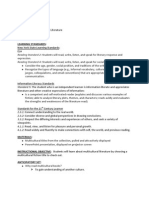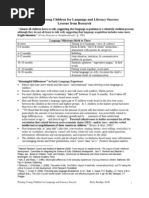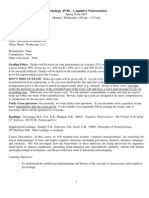Summaries of ELPS
Summaries of ELPS
Uploaded by
mmanzan1Copyright:
Available Formats
Summaries of ELPS
Summaries of ELPS
Uploaded by
mmanzan1Copyright
Available Formats
Share this document
Did you find this document useful?
Is this content inappropriate?
Copyright:
Available Formats
Summaries of ELPS
Summaries of ELPS
Uploaded by
mmanzan1Copyright:
Available Formats
Summaries of ELPS: Proficiency Level Descriptors
(subsection d)
LEVEL The student comprehends 1A(i) few simple conversations with linguistic support 1A(ii) modified conversation
Listening (d1: k-12)
The student speaks
Speaking (d2: k-12)
2A(i) using single words and short phrases with practiced material; tends to give up on attempts 2A(ii) using limited bank of key vocabulary 2A(iii) with recently practiced familiar material 2A(iv) with frequent errors that hinder communication 2A(v) with pronunciation that inhibits communication
The student reads
Reading (d4: 2-12)
4A(i) little except recently practiced terms, environmental print, high frequency words, concrete words represented by pictures 4A(ii) slowly, word by word 4A(iii) with very limited sense of English structure 4A(iv) with comprehension of practiced, familiar text 4A(v) with need for visuals and prior knowledge 4A(vi) modified and adapted text
Writing (d6: 2-12)
The student writes
6A(i) with little ability to use English 64A(ii) without focus and coherence, conventions, organization, voice 6A(iii) labels, lists, and copies of printed text and highfrequency words/phrases, short and simple, practiced sentences primarily in present tense with frequent errors that hinder or prevent understanding
Beginning (A)
1A(iii) few words, does not seek clarification, watches others for cues
Intermediate (B)
1B(i) unfamiliar language with linguistic supports and adaptations 1B(ii) unmodified conversation with key words and phrases 1B(iii) with requests for clarification by asking speaker to repeat, slow down, or rephrase speech
2B(i) with simple messages and hesitation to think about meaning 2B(ii) using basic vocabulary 2B(iii) with simple sentence structures and present tense 2B(iv) with errors that inhibit unfamiliar communication 2B(v) with pronunciation generally understood by those familiar with English language learners 2C(i) in conversations with some pauses to restate, repeat, and clarify 2C(ii) using content-based and abstract terms on familiar topics 2C(iii) with past, present, and future 2C(iv) using complex sentences and grammar with some errors 2C(v) with pronunciation usually understood by most
4B(i) wider range of topics: and everyday academic language 4B(ii) slowly and rereads 4B(iii) basic language structures 4B(iv) simple sentences with visual cues, pretaught vocabulary and interaction 4B(v) grade-level texts with difficulty 4B(vi) at high level with linguistic accommodation 4C(i) abstract grade appropriate text 4C(ii) longer phrases and familiar sentences appropriately 4C(iii) while developing the ability to construct meaning from text 4C(iv) at high comprehension level with linguistic support for unfamiliar topics and to clarify meaning 4D(i) nearly comparable to native speakers 4D(ii) grade appropriate familiar text appropriately 4D(iii) while constructing meaning at near native ability level 4D(iv) with high level comprehension with minimal linguistic support
6B(i) with limited ability to use English in content area writing 6B(ii) best on topics that are highly familiar with simple English 6B(iii) with simple oral tone in messages, high-frequency vocabulary, loosely connected text, repetition of ideas, mostly in the present tense, undetailed descriptions, and frequent errors 6C(i) grade appropriate ideas with second language support 6C(ii) with extra need for second language support when topics are technical and abstract 6C(iii) with a grasp of basic English usage and some understanding of complex usage with emerging gradeappropriate vocabulary and a more academic tone 6D(i) grade appropriate content area ideas with little need for linguistic support 6D(ii) develop and demonstrate grade appropriate writing 6D(iii) nearly comparable to native speakers with clarity and precision, with occasional difficulties with naturalness of language
Advanced (C)
1C(i) with some processing time, visuals, verbal cues, and gestures; for unfamiliar conversations 1C(ii) most unmodified interaction 1C(iii) with occasional requests for the speaker to slow down, repeat, rephrase, and clarify meaning
Advanced High (D)
1D(i) longer discussions on unfamiliar topics 1D(ii) spoken informati on nearly comparable to native speaker 1D(iii) with few requests for speaker to slow down, repeat, or rephrase
2D(i) in extended discussions with few pauses 2D(ii) using abstract contentbased vocabulary except low frequency terms; using idioms 2D(iii) with grammar nearly comparable to native speaker 2D(iv) with few errors blocking communication 2D(v) occasional mispronunciation
*These summaries are not appropriate to use in formally identifying student proficiency levels for TELPAS. TELPAS assessment and training materials are provided by the Texas Education Agency Student Assessment Division: http://www.tea.state.tx.us/index3.aspx?id=3300&menu_id3=793 Used with permission from Canter Press, 2008.
ELPS Resource Supplement
Texas Education Agency / Education Service Center, Region 20
19
You might also like
- ELPS Cheat SheetDocument3 pagesELPS Cheat SheetJames Churchill100% (6)
- Reading Level TestDocument2 pagesReading Level TestHomeschool Base100% (25)
- Wayne Wright PowerPointDocument176 pagesWayne Wright PowerPointCamila Veilchen Oliveira75% (4)
- Phonemic Awareness Lesson PlanDocument2 pagesPhonemic Awareness Lesson Planapi-31194242875% (4)
- Ted Talk Worksheet PDFDocument1 pageTed Talk Worksheet PDFJosé Luis100% (2)
- Using the Workshop Approach in the High School English Classroom: Modeling Effective Writing, Reading, and Thinking Strategies for Student SuccessFrom EverandUsing the Workshop Approach in the High School English Classroom: Modeling Effective Writing, Reading, and Thinking Strategies for Student SuccessRating: 4.5 out of 5 stars4.5/5 (3)
- The 57 BusDocument7 pagesThe 57 Busapi-495321566No ratings yet
- Strategies for Teaching English Language, Literature, and ContentFrom EverandStrategies for Teaching English Language, Literature, and ContentRating: 5 out of 5 stars5/5 (3)
- Anne Frank Lesson Plan & UnitDocument126 pagesAnne Frank Lesson Plan & UnitLisa Ward100% (3)
- Mechanically InclinedDocument216 pagesMechanically InclinedJake100% (2)
- Henrys Freedom Box Lesson PlanDocument5 pagesHenrys Freedom Box Lesson Planapi-354007473No ratings yet
- Fifth Grade Poetry UnitDocument52 pagesFifth Grade Poetry Unitapi-235388309100% (1)
- Guidelines For Linguistic AccommodationsDocument1 pageGuidelines For Linguistic Accommodationsmmanzan1100% (1)
- Texas TExES ESL Supplemental (154) Book + OnlineFrom EverandTexas TExES ESL Supplemental (154) Book + OnlineRating: 5 out of 5 stars5/5 (1)
- Words Their Way Word Sorts For Syllables and Affixes Spellers 1Document14 pagesWords Their Way Word Sorts For Syllables and Affixes Spellers 1api-324790096100% (2)
- Body Paragraph Lesson PlanDocument3 pagesBody Paragraph Lesson Planapi-532262279No ratings yet
- Among The Hidden RAFT ProjectDocument3 pagesAmong The Hidden RAFT Projectshonam160% (1)
- Emotional Intelligence NotesDocument24 pagesEmotional Intelligence NotesFatima Malik80% (5)
- The Relationships Among Social Intelligence Emotional Intelligence and Cultural IntelligenceDocument17 pagesThe Relationships Among Social Intelligence Emotional Intelligence and Cultural IntelligencehalleyworldNo ratings yet
- LSRWDocument15 pagesLSRWRishi Kasyap89% (9)
- Argument Lesson PlanDocument45 pagesArgument Lesson PlanIsferra Rezana binti Ismet NayanNo ratings yet
- Multisyllabic Words Lesson PlanDocument3 pagesMultisyllabic Words Lesson Planapi-389758204No ratings yet
- Stages of Second Language AcquisitionDocument10 pagesStages of Second Language AcquisitionIvan JozefNo ratings yet
- Seventh Grade Guided Reading and Bda Rev 2014Document8 pagesSeventh Grade Guided Reading and Bda Rev 2014api-257262131No ratings yet
- Reading Foundations Test PrepDocument26 pagesReading Foundations Test Prepapi-287131480100% (3)
- LIT13 TeachingReadingComprehensionFINALDRAFTDocument112 pagesLIT13 TeachingReadingComprehensionFINALDRAFTJoyce PrivadoNo ratings yet
- The Notice and Note Signposts Definitions Poster - E. KurasDocument1 pageThe Notice and Note Signposts Definitions Poster - E. Kuraselizabethkuras100% (5)
- Gradual Release and Scaffolds For ElsDocument1 pageGradual Release and Scaffolds For Elsapi-237154393100% (1)
- Lesson Plan Template For Student Teaching and The Caltpa: Preparation To TeachDocument3 pagesLesson Plan Template For Student Teaching and The Caltpa: Preparation To Teachapi-3465264950% (1)
- Siop 99 Ideas ActivitiesDocument9 pagesSiop 99 Ideas Activitiesapi-305101515No ratings yet
- Robust Vocabulary InstructionDocument4 pagesRobust Vocabulary Instructionmadhu_gopinathanNo ratings yet
- Multicultural Literature Lesson PlanDocument2 pagesMulticultural Literature Lesson PlancstorzNo ratings yet
- Step Up To WritingDocument7 pagesStep Up To Writingzfmf025366100% (1)
- Learning Theories Cheat Sheet 1Document2 pagesLearning Theories Cheat Sheet 1api-490667843No ratings yet
- 8.2.1.A TestingTheSensesDocument3 pages8.2.1.A TestingTheSensesjackson colemanNo ratings yet
- Aural RehabilitationDocument28 pagesAural Rehabilitationapi-403585640100% (1)
- Elps PldsaccommodationschartDocument2 pagesElps Pldsaccommodationschartapi-290666062100% (1)
- Strategies For Teaching Content To ELLsDocument22 pagesStrategies For Teaching Content To ELLsmike dNo ratings yet
- Unit 6 (Weeks 13-16) : Introduction To Poetry Fora9 Grade English Language Arts ClassroomDocument55 pagesUnit 6 (Weeks 13-16) : Introduction To Poetry Fora9 Grade English Language Arts Classroomapi-317392151100% (1)
- Daily Instruction For Beginning ELLs (Excerpt From The ESL/ELL Teacher's Survival Guide)Document10 pagesDaily Instruction For Beginning ELLs (Excerpt From The ESL/ELL Teacher's Survival Guide)Jossey-Bass EducationNo ratings yet
- Ell LessonsDocument8 pagesEll Lessonsapi-489680668No ratings yet
- Literacy-Building Interview Activities For English Language LearnersDocument80 pagesLiteracy-Building Interview Activities For English Language LearnersDanny FergusonNo ratings yet
- 9-12 ESL CurriculumDocument104 pages9-12 ESL CurriculumKirin MalikNo ratings yet
- Poetry Writing PoetryDocument6 pagesPoetry Writing Poetryjohn smithNo ratings yet
- Fictional Narrative Writing UnitDocument6 pagesFictional Narrative Writing Unitapi-288753185No ratings yet
- Practical Reading Strategies: Engaging Activities for Secondary StudentsFrom EverandPractical Reading Strategies: Engaging Activities for Secondary StudentsNo ratings yet
- Drama Lesson Plan For The Recess QueenDocument3 pagesDrama Lesson Plan For The Recess QueenozkimmyNo ratings yet
- Esperanza RisingDocument16 pagesEsperanza Risingapi-269196756100% (2)
- Writers Workshop PDFDocument28 pagesWriters Workshop PDFMariluz OrtegaNo ratings yet
- Morphology AwareDocument12 pagesMorphology AwareHendri Lidayani100% (1)
- Unit PlanDocument54 pagesUnit Planbloomuhuskie100% (2)
- So, You Want to Become a National Board Certified Teacher: Workbook & Evidence ManualFrom EverandSo, You Want to Become a National Board Certified Teacher: Workbook & Evidence ManualRating: 2 out of 5 stars2/5 (1)
- Simile Metaphor Lesson PlanDocument8 pagesSimile Metaphor Lesson Planapi-385521781No ratings yet
- 5th GR Writing Resource PacketDocument85 pages5th GR Writing Resource PacketJamal AK100% (5)
- MarazanoVocabularyDevelopment2 12 06 PDFDocument48 pagesMarazanoVocabularyDevelopment2 12 06 PDFSankar SasmalNo ratings yet
- Three Approaches Phonics PDFDocument2 pagesThree Approaches Phonics PDFJasmin Rasonable - BantaNo ratings yet
- Everyone Reading: March 1, 2016Document56 pagesEveryone Reading: March 1, 2016Aruba Ashhar100% (1)
- ESOL Study Guide-WEBDocument176 pagesESOL Study Guide-WEBfjmcgrath111100% (1)
- 5th Grade Writing Process Lesson Plan PoemDocument7 pages5th Grade Writing Process Lesson Plan Poemapi-351315587No ratings yet
- Listening and Speaking Activities Grade 6Document32 pagesListening and Speaking Activities Grade 6karachi550% (2)
- ELT TPR Lesson PlanDocument43 pagesELT TPR Lesson PlanCam Jays0% (1)
- UNLV/Department of Teaching & Learning Secondary Lesson Plan TemplateDocument5 pagesUNLV/Department of Teaching & Learning Secondary Lesson Plan Templateapi-463538537No ratings yet
- Priming Young Children For Language and Literacy Success: Lessons From ResearchDocument4 pagesPriming Young Children For Language and Literacy Success: Lessons From ResearchAnindita PalNo ratings yet
- Benefits of Teaching Poetry - Why Teach PoetryDocument3 pagesBenefits of Teaching Poetry - Why Teach Poetryapi-2932149310% (1)
- Political Neuromarketing PDFDocument86 pagesPolitical Neuromarketing PDFAshish MathurNo ratings yet
- Factor /affect SlaDocument5 pagesFactor /affect Sla黃婷婷No ratings yet
- A Wandering Mind Is An Unhappy Mind: References and NotesDocument2 pagesA Wandering Mind Is An Unhappy Mind: References and NotesressbNo ratings yet
- Apa Analysis: Ginther, A. (2013) - Assessment of Speaking. The Doi: 10.1002/9781405198431.wb Eal0052Document3 pagesApa Analysis: Ginther, A. (2013) - Assessment of Speaking. The Doi: 10.1002/9781405198431.wb Eal0052ANGELA ANDREANo ratings yet
- Scholl, 2001Document46 pagesScholl, 2001Pablo Ignacio Nova BaezaNo ratings yet
- Tune Into ReadingDocument2 pagesTune Into Readingapi-492129988No ratings yet
- Research Essay - ArrowoodDocument11 pagesResearch Essay - Arrowoodapi-549711872No ratings yet
- Physical, Cognitive and Socio-Emotional Development of Intermediate LearnersDocument1 pagePhysical, Cognitive and Socio-Emotional Development of Intermediate LearnersTracy Heart LicupNo ratings yet
- Message Channel: ReceiverDocument3 pagesMessage Channel: Receivermarielle motel92% (12)
- Contemporary Arts ProductionDocument18 pagesContemporary Arts ProductionAnna Philomena Ferrer100% (2)
- Tips On How To Study Fast and EffectivelyDocument13 pagesTips On How To Study Fast and EffectivelyMysteriousNo ratings yet
- Body Mirror: Genesis D. OraaDocument14 pagesBody Mirror: Genesis D. OraaGenesis Dela CruzNo ratings yet
- UT Dallas Syllabus For nsc4v90.002.07s Taught by Bart Rypma (bpr061000)Document7 pagesUT Dallas Syllabus For nsc4v90.002.07s Taught by Bart Rypma (bpr061000)UT Dallas Provost's Technology GroupNo ratings yet
- Chapter 3: Understanding Customer Behaviour: Baines, Fill, & Page: Essentials of MarketingDocument19 pagesChapter 3: Understanding Customer Behaviour: Baines, Fill, & Page: Essentials of MarketingRahul BarnwalNo ratings yet
- Definition of Met A Linguistic AwarenessDocument2 pagesDefinition of Met A Linguistic AwarenessBebed HonestyNo ratings yet
- Ericsson Roring and Nandagopal 2007Document54 pagesEricsson Roring and Nandagopal 2007siijiiNo ratings yet
- Learning Domains and Effective Delivery of Instruction by Cindy Vinson Ed.DDocument11 pagesLearning Domains and Effective Delivery of Instruction by Cindy Vinson Ed.DAngelo Garret V. LaherNo ratings yet
- Syllabus: Psychology of Music For MusiciansDocument4 pagesSyllabus: Psychology of Music For MusiciansCaroline DavisNo ratings yet
- Data Collection LearningDocument5 pagesData Collection Learningpurbi ACHARYANo ratings yet
- Auditory Skill Hierarchy PDFDocument1 pageAuditory Skill Hierarchy PDFErsya MusLih AnshoriNo ratings yet
- The Brain-Changing Benefits of Exercise - Wendy SuzukiDocument5 pagesThe Brain-Changing Benefits of Exercise - Wendy SuzukiAF Ann RossNo ratings yet
- CommunicationDocument18 pagesCommunicationD. J. Anderson B.No ratings yet

























































































